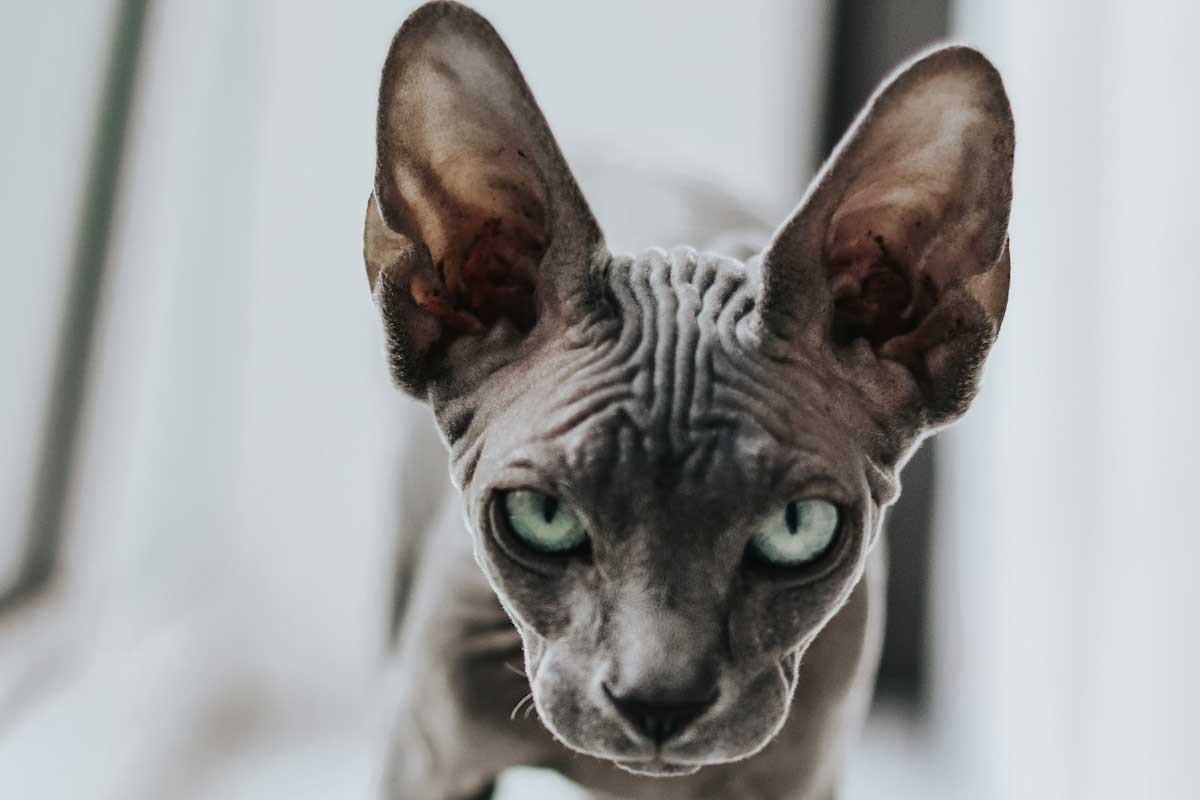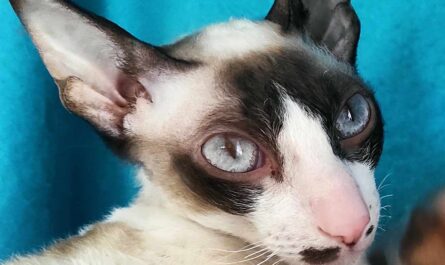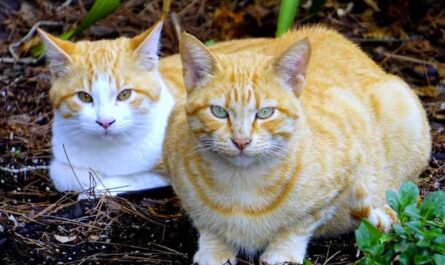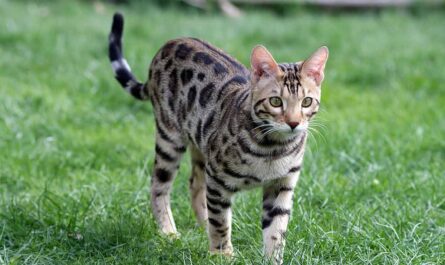My cat is acting strange and scared. Why and what to do? Decoding the reasons behind your cat’s strange and scared behavior requires a holistic approach. By considering health, environment, social dynamics, and a myriad of other factors, you can embark on a journey to restore your feline friend’s equilibrium, fostering a harmonious and happy coexistence. Cats, renowned for their independent and solitary nature, often exhibit a penchant for seclusion. This inclination is perfectly normal, and you might frequently observe your feline companion seeking refuge under furniture or beds for undisturbed naps. Such solitary moments can be perceived as inherent to their character.
However, a shift towards prolonged periods of concealment accompanied by unusual behavior may warrant closer scrutiny. Delving into the reasons behind your cat’s extended hiding spells becomes imperative, allowing for a comprehensive understanding of their well-being.
My Cat is Acting Strange and Scared: Why?
Enigmatic and elusive, cats intertwine themselves into the fabric of our lives, their mysterious nature often leaving owners bewildered and anxious. The perplexity deepens when a once confident and independent feline companion adopts an unexpected demeanor, shrouding itself in an aura of fear and uncertainty. What arcane forces could be at play, prompting this sudden shift in behavior? Let us embark on an intricate exploration of feline idiosyncrasies to unravel the enigma that veils our feline friends.
1. Social Dynamics: The Complex Cat Community
In the intricate tapestry of feline social dynamics, cats, often perceived as solitary creatures, reveal a nuanced layer of interconnected relationships. Within the confines of a multi-cat household, a subtle ballet of dominance struggles, jealousy, and personality clashes unfolds. The seemingly independent nature of cats belies the intricate web of hierarchies that govern their interactions. Behavioral shifts, sometimes subtle and at other times dramatic, are the visible manifestations of the intricate social dance.
The ebb and flow of the feline social tapestry can be as perplexing as it is fascinating. Changes in these dynamics have the potential to unsettle the delicate balance, leaving a cat feeling threatened or apprehensive. Scrutinizing the nuanced interactions between these furry companions becomes a window into their social world. Through careful observation, one can decipher the cryptic language of feline body cues and vocalizations, gaining valuable insights into the root cause of any unsettling behavior.
2. Past Trauma: Lingering Shadows
Beneath the velvety coat and bewitching eyes, cats may carry the unspoken burdens of past traumas. Their remarkable memories, a double-edged sword, can bear the weight of negative experiences that cast lingering shadows on their present demeanor. This is particularly poignant in the case of adopted or rescued cats, whose behavior may be a silent echo of past hardships.
For these feline survivors, the path to healing requires patience and understanding. Creating an environment that serves as a sanctuary becomes paramount. A safe space where the echoes of past trauma can gradually fade away, replaced by a newfound sense of security. Building trust with these cats demands a gentle touch and an empathetic understanding of the scars that may not be visible to the naked eye.
3. Health Matters: A Silent Cat Communicator
Beneath the sleek exterior of feline grace lies a silent communicator—their behavior. Unraveling the cryptic code of your cat’s peculiar actions begins with a meticulous consideration of their health. These masters of stoicism adeptly conceal ailments, subtly signaling distress through altered behaviors. Whether it’s a subtle shift in appetite or a reluctance to engage in playful antics, these are the whispers of a cat grappling with an underlying health issue. From dental maladies to internal discomfort, the journey of understanding necessitates a pilgrimage to the veterinarian’s realm. An inconspicuous alteration in behavior becomes the compass guiding vigilant owners through the labyrinth of feline health.
4. Environmental Stressors: A Symphony of Sensitivities
In the harmonious rhythm of a cat’s life, any discordant note, be it a new piece of furniture or a subtle shift in household dynamics, can resonate with profound consequences. These creatures of habit, finding solace in routine and familiarity, are exquisitely sensitive to changes in their environment. Anxiety, an invisible orchestrator, conducts a symphony of stressors—unfamiliar scents, disconcerting sounds—that manifests in peculiar behaviors. The once playful pounce transforms into elusive hide-and-seek, or meticulous grooming becomes excessive, signaling a desperate attempt to regain equilibrium. In the delicate dance of understanding, decoding and mitigating these environmental stressors becomes the key to restoring the felicitous balance of your cat’s serenity.
5. Sensory Overload: A World of Intensity
In the feline realm, the senses are not just tools but gateways to a world of intensity. Cats, equipped with finely tuned senses, navigate their environment with a heightened awareness that can, at times, border on vulnerability. The play of light, the symphony of sounds, and the olfactory kaleidoscope can either be sources of joy or triggers of anxiety.
The delicate equilibrium of a cat’s emotional state is susceptible to disruption by changes in lighting, abrupt loud noises, or overpowering odors. Identifying and mitigating these sensory stimuli becomes a crucial endeavor in restoring a cat’s equilibrium. It involves decoding the sensory symphony that shapes their perception and tailoring the environment to be a harmonious melody rather than a discordant cacophony.
6. Aging Gracefully: The Inevitable Passage of Time
As the pendulum of time swings, cats, once sprightly and full of feline grace, traverse the inevitable path of aging. The golden years may bring with them physical discomfort and cognitive decline, casting a subtle shadow on the once-vibrant spirit. Arthritis, diminished eyesight, or the gradual waning of hearing can transform the familiar landscape of a cat’s world into a terrain of newfound vulnerability.
In the twilight of their lives, regular veterinary check-ups become not just a routine but a lifeline. Addressing age-related issues with a vigilant eye ensures the well-being of these aging companions. The dance with time demands a compassionate response, acknowledging the evolving needs of a senior cat and adapting their surroundings to provide comfort and support.
7. Boredom Blues: A Creative Cure
Within the vivacious spirit of a cat lies an inherent need for mental and physical stimulation. Boredom, a subtle adversary, can cast a gloom over their otherwise playful disposition. The cure for these feline blues lies not in pharmaceutical elixirs but in the creative orchestration of an enriched environment.
Interactive toys become instruments of joy, scratching posts morph into artistic expressions of feline instinct, and engaging activities transform into the choreography of a lively dance. Understanding the essence of a cat’s playfulness and integrating it into their living space becomes a dynamic remedy for restlessness, anxiety, and peculiar behaviors. The canvas of a cat’s world is painted with vibrant hues of creative stimulation, providing a healthy outlet for their boundless energy.
8. Changes in Routine: The Fabric of Feline Comfort
Cats, those enigmatic creatures of feline grace, are not just creatures of habit; they are fervent enthusiasts of routine, reveling in the comforting predictability of their daily lives. The very fabric of their well-being is intricately woven into the rhythms of their existence. Any abrupt deviation from their established norms, whether it be a shift in feeding schedules or an alteration in the sacred ritual of playtime, can cast a disorienting shadow upon their delicate equilibrium, leaving them in a state of palpable anxiety.
To mitigate this, the wisdom lies in the art of gradual transitions. Like a carefully choreographed dance, changes should be introduced with a measured grace that respects the cat’s need for familiarity. The canvas of their daily regimen, once painted with the brushstrokes of consistency, must not be marred by impulsive strokes of change. It is in this delicate dance of routine that the prevention of behavioral disruptions finds its sanctuary.
9. Weathering the Storm: Atmospheric Influences
In the realm of feline psychology, the weather is not merely a capricious force that governs the external world; it is an atmospheric maestro that orchestrates the very mood and comportment of our feline friends. Thunderstorms, those booming crescendos of nature, and the explosive spectacles of fireworks are not mere auditory disruptions—they are symphonic dissonances that can reverberate through a cat’s sensitive psyche.
Even the subtle shifts in atmospheric pressure, imperceptible to human senses, can be the unseen puppeteer pulling the strings of feline anxiety. Thus, in the face of tumultuous weather conditions, the conscientious cat caregiver becomes the architect of a secure sanctuary. A quiet, sheltered space, shielded from the auditory onslaught of the storm, becomes the refuge where a cat can weather the atmospheric tempest with a profound sense of security.
10. Medical Treatments: A Prescription for Peculiarity
In the intricate ballet of feline behavior, medications emerge as potent choreographers, wielding the power to induce a symphony of changes in a cat’s demeanor. Whether dispensed as a prescription or procured over theounter, these chemical agents are not without their influence on the delicate tapestry of feline behavior. A vigilant guardian must not only administer these remedies with precision but also remain attuned to the subtle nuances of their potential side effects.
The odyssey through the labyrinth of pharmaceutical interventions demands an acute awareness of any peculiarities in a cat’s conduct. Should the cat, once a paragon of feline normalcy, exhibit a sudden deviation into the realms of peculiarity, the clarion call is to consult with a trusted veterinarian. In this dialogue, adjustments to dosage or exploration of alternative treatments may be the necessary instruments to harmonize the discordant notes of a cat’s behavioral composition.
11. Dietary Dilemmas: The Culinary Connection
The culinary tableau is not a trivial stage in the drama of feline comportment; it is a pivotal arena where the intricate interplay of diet and demeanor unfolds. A cat’s digestive symphony, delicately tuned to the notes of a balanced diet, can face dissonance with sudden gustatory shifts. Allergies, intolerances, or the mere introduction of a new gastronomic protagonist can lead to gastrointestinal unrest, casting shadows over the cat’s once-stable behavioral landscape.
In the culinary labyrinth, the discerning caretaker becomes a culinary curator, crafting a menu that is not just a feast for the palate but a balm for the emotional well-being of their feline companion. The dietary equilibrium becomes a linchpin in the maintenance of both physical vitality and emotional equilibrium, where the selection of sustenance is a nuanced art, navigating the intricate pathways of nutritional needs and gustatory preferences.

12. Emotional Bonding: The Human-Feline Nexus
Behind the veil of feline independence lies a profound truth—the fabric of the human-feline bond is woven with threads of emotional connectivity. The seemingly stoic cat, with its inscrutable gaze, is not impervious to the currents of human emotion. Changes in the emotional weather of their human companions send ripples through the feline psyche, manifesting in subtle shifts of behavior that speak volumes.
In this intricate nexus, the human companion holds the brush to paint the emotional landscape of the feline world. Quality time becomes the palette with which to create vibrant hues of reassurance. The gentle strokes of bonding, the whispered promises of constancy, and the nurturing embrace of companionship are the tools to mend the frayed edges of feline anxiety. In this dance of reciprocity, the restoration of a cat’s confidence becomes not just a duty but a shared journey of emotional well-being.
13. Professional Guidance: The Expert’s Touch
When the labyrinth of feline behavior becomes an enigma too intricate to decipher, the sage recourse lies in the hands of the expert—an animal behaviorist, a maestro in the symphony of feline psychology. This seasoned guide undertakes a meticulous examination, unraveling the strands of the cat’s environment, history, and behavior with the precision of a forensic investigator.
In the hands of the expert, the arcane becomes elucidated. Tailored strategies emerge, a bespoke roadmap to address and rectify the underlying issues that weave a tapestry of distress in the feline soul. It is in this realm of professional insight that the cat caregiver finds solace, trusting in the expertise that can decipher the cryptic language of feline behavior, offering not just solutions but a profound understanding of the intricate psyche that is the essence of the enigmatic cat.
14. Territorial Tensions: The Invisible Battle
Within the intricate tapestry of feline psychology, territorial instincts form an invisible battleground. Encroachment upon their space, perceived through the lens of feline guardianship, triggers a cascade of defensive behaviors. Whether new interloper prowls outside the window or a furry addition to the household alters the established order, territorial tensions surface as skittishness and avoidance. The complex web of triggers demands recognition—a nuanced understanding of the invisible borders defining your cat’s realm. Only by navigating this labyrinth of territorial dynamics can a harmonious environment be forged, appeasing the invisible sentinels guarding the sanctity of your feline companion’s domain.
When should I be concerned about a cat hiding?
The enigmatic nature of feline behavior often conceals subtle cues that can be windows into their well-being. While seeking solace in the shadows is a norm in the feline playbook, it assumes a more nuanced dimension when it becomes a pronounced pattern. The labyrinth of feline psychology suggests that providing an array of secluded sanctuaries is not merely a caprice but a fundamental tenet of feline welfare. However, should your cat undergo a seismic shift, cloaking itself more frequently in the veil of seclusion, it beckons the need for a discerning gaze. The cryptic language of feline discomfort might unfurl itself through ancillary indicators such as heightened stress levels, palpable anxiety, or even the specter of an underlying malady.
Do cats hide when they are sick?
Peering into the evolutionary echo chamber, the genesis of a cat’s inclination to retreat into the recesses of concealment when unwell finds resonance in survival instincts etched in the annals of wild feline history. In the primal dance of predator and prey, an ailing or injured feline becomes a beacon for opportunistic adversaries. Hence, the art of hiding is not merely a coping mechanism; it is an evolutionary tableau of self-preservation. Our domesticated feline companions, descendants of their wild forebears, instinctively weave this cloak of invisibility around themselves when grappling with health tribulations. To discern a cat in the throes of malaise is to decipher the silent dialogue of withdrawal, a choreography encoded in their genetic tapestry.
How To Get Your Cat Out Of Hiding?
The reasons behind a cat’s prolonged seclusion can be multifaceted. While occasional retreats for solitary repose are considered normal, persistent hiding may signal distress or anxiety. Identifying the underlying causes becomes crucial in providing the appropriate intervention and ensuring your feline companion’s mental and physical health. Incorporating the following multifaceted and nuanced approaches into your interpersonal dynamics with your feline confidant possesses the dual efficacy of facilitating their return to the open while concurrently nurturing a relationship grounded in trust and mutual comfort.
1. Avoiding Forceful Measures
Resisting the impulse to forcefully extricate your elusive feline from its chosen refuge is paramount. Any attempt to seize them abruptly may, regrettably, amplify their preexisting anxiety, potentially triggering defensive responses. The ramifications of such an interaction could manifest in the form of scratches or bites, exacerbating the situation and, alarmingly, cultivating a negative correlation between yourself and the supposed haven your cat sought.
2. Embracing a Hands-off Approach
In the delicate art of coaxing a cat out of hiding, a strategic and deliberate hands-off approach emerges as a remarkably effective tactic. While alluring incentives like delectable treats and engaging toys wield influence, the linchpin is undeniably patience. By affording your cat the temporal latitude and spatial autonomy they demand, you empower them to dictate the tempo of their reemergence, a process governed by their intrinsic comfort.
3. Tailoring the Environment
The orchestration of a conducive environment is contingent upon an intimate understanding of your cat’s idiosyncratic needs. If stress-inducing factors—be they unfamiliar individuals or the sudden advent of new pets—loom large, a judicious strategy involves isolating these potential triggers. Implementing nuanced adjustments, such as selectively closing doors or availing oneself of soothing products, contributes tangibly to the cultivation of a serene and harmonious milieu. Cat accessories on Amazon
4. Enticement Through Food and Play
The strategic leverage of a cat’s proclivity for gastronomic indulgence and playtime revelry assumes the mantle of a potent persuasion tool. Dispensing favored treats or engaging in interactive play not only proves motivational but also functions as a compelling catalyst for a hesitant feline’s foray into the open. The artful placement of wet food, dry kibble, or alluring treats strategically near their concealed sanctuary acts as an irresistible lure, facilitating the gradual bridging of the gap between the covert refuge and the expansive realm beyond.
4. Trigger Identification and Elimination
A vigilant scrutiny of your cat’s surroundings is indispensable for the identification and subsequent elimination of potential triggers. Whether the culprits are enigmatic interlopers or alterations in the neighborhood fabric, their swift removal or minimization is pivotal. Should the triggers elude immediate detection, the deployment of anxiety-reducing stratagems—ranging from calming sprays to the subtle diffusion of pheromones—can serve as efficacious palliatives. See why thousands of cats love BoxCat
How do I know when my cat is ill?
Unlocking the enigma of feline health demands a nuanced understanding of the intricate tapestry of their behavioral symphony. As masters of concealment, cats, when afflicted by maladies, adeptly veil the telltale signs of vulnerability. The clandestine ballet of illness manifests not only in the physical realm but resonates through the ethereal corridors of mood, demeanor, and activity. The discerning observer is tasked with deciphering the subtle cadence of change, be it in the mercurial fluctuations of appetite, the rhythmic pulse of thirst, or the altered choreography of defecation and urination. The feline canvas, when brushed with the hues of ailment, is a multidimensional panorama, demanding a keen eye attuned to the nuances of their intricate language of distress.
Other Interesting Articles
- Cornish Rex Cat Breed: Profile, Traits, Health, Grooming, Care
- Colorpoint Shorthair Cat Breed: Profile, Traits, Grooming, Care
- Cheetoh Cat Breed: Profile, Traits, Health, Grooming, Care
- Chausie Cat Breed: Profile, Traits, Health, Grooming, Care
- Chartreux Cat Breed: Profile, Traits, Health, Grooming, Care
- Chantilly, or Tiffany Cat Breed: Profile, Traits, Grooming, Care
- Cymric Cat Breed: Profile, Traits, Health, Grooming, Care
- Dragon Li Cat Breed: Profile, Traits, Health, Grooming, Care
- Donskoy Cat Breed: Profile, Traits, Health, Grooming, Care
- European Shorthair Cat: Profile, Traits, Health, Grooming, Care
- German Rex Cat Breed: Profile, Traits, Health, Grooming, Care
- Havana Brown Cat Breed: Profile, Traits, Coats, Groom, Care
- Kurilian Bobtail Cat Breed: Profile, Traits, Coats, Groom, Care
- Korat Cat Breed Profile: Health, Traits, Coats, Groom, Care
- Javanese Cat Breed Profile: Health, Traits, Coats, Groom, Care
- Japanese Bobtail Cat Profile: Health, Traits, Coats, Groom, Care
- LaPerm Cat Breed Profile: Health, Traits, Coats, Groom, Care
- Manx Cat Breed Profile: Health, Traits, Coats, Groom, Care
- Nebelung Cat Breed Profile: Health, Traits, Groom, Care
- Norwegian Forest Breed Profile: Health, Traits, Groom, Care



